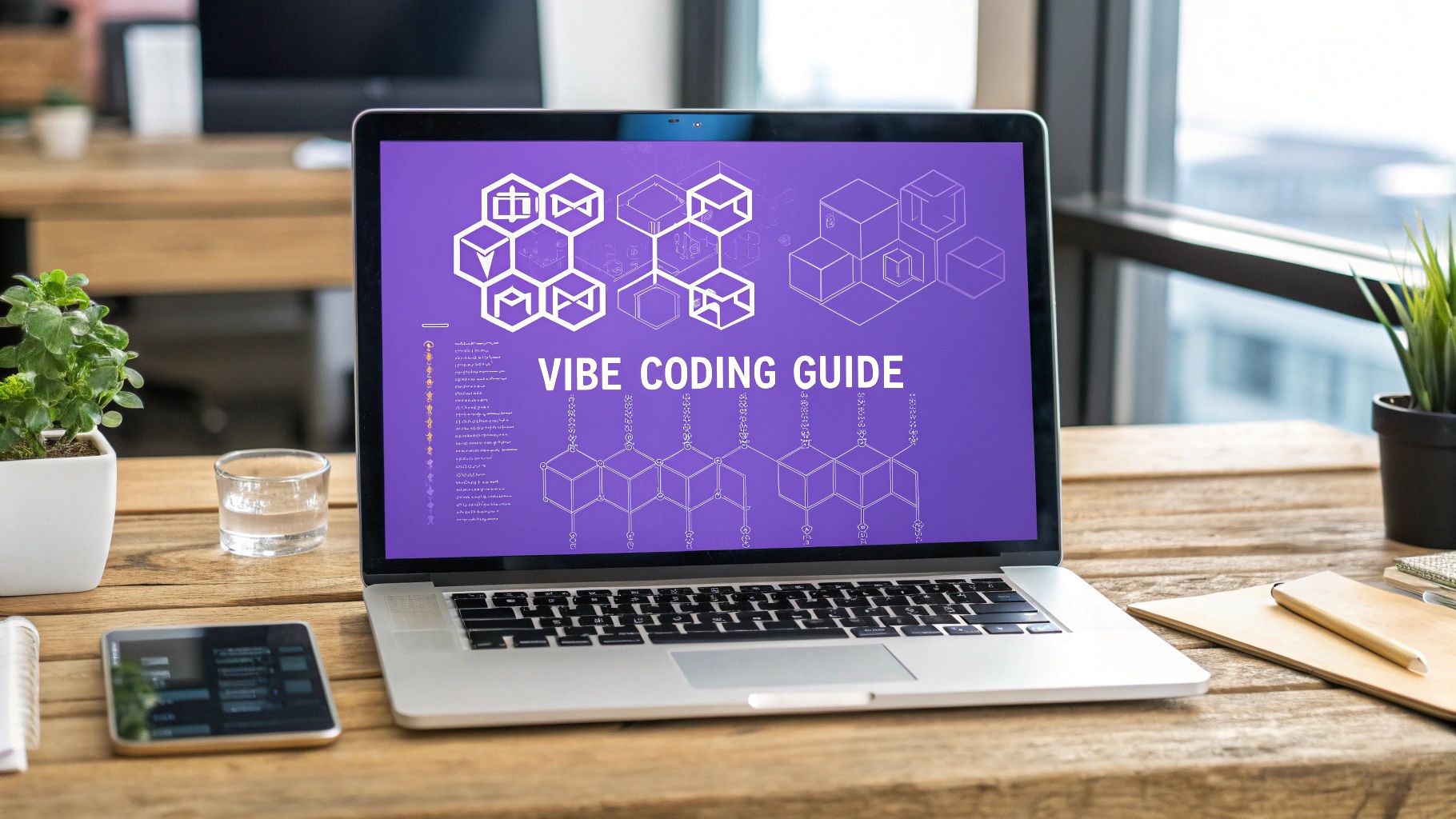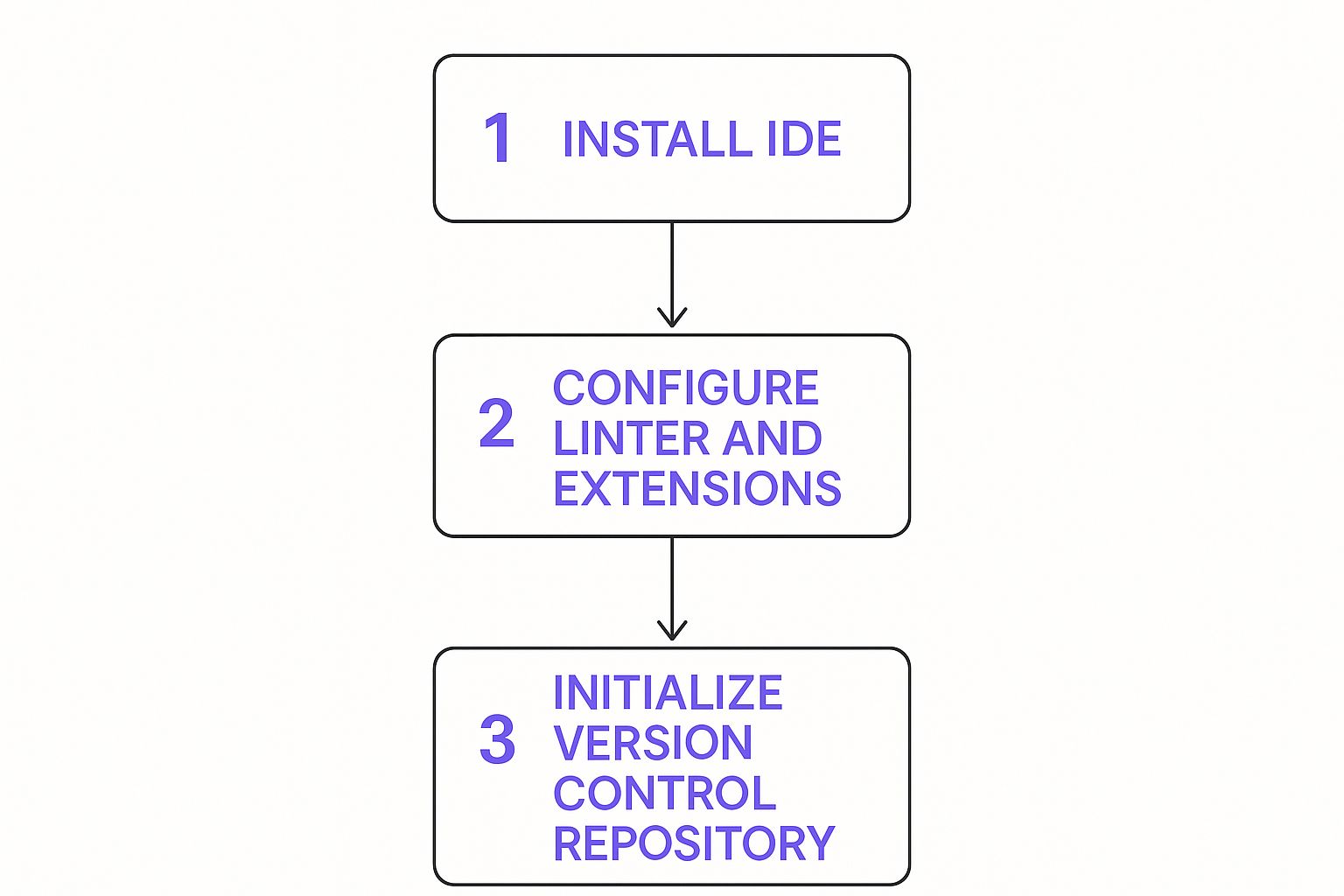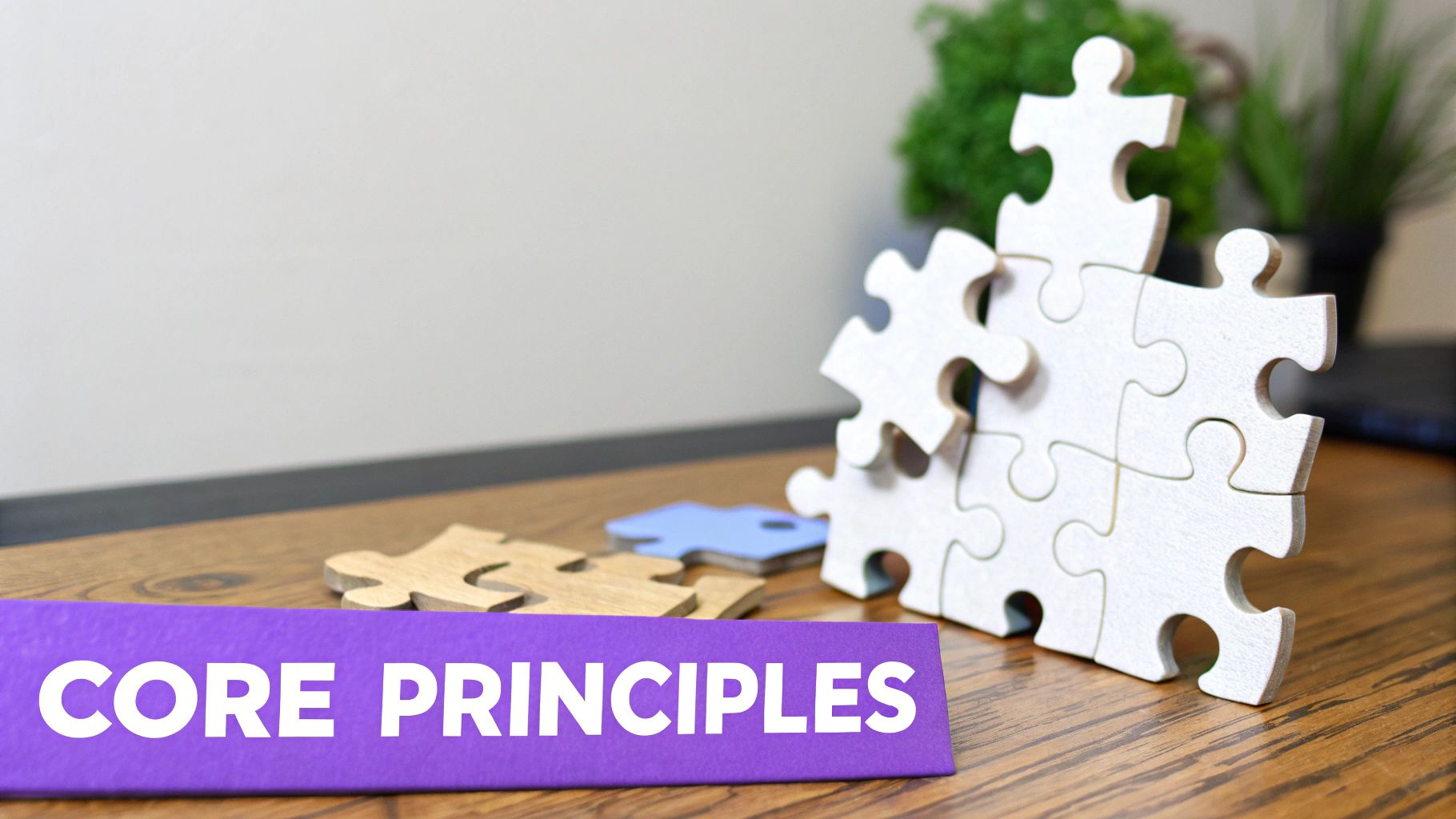Your Vibe Coding Guide to Building Onchain Apps

Let's talk about building real-world apps with vibe coding. If you're here, you probably get the core idea: you bring the vision, the vibe, and an AI translates it into production-ready code. This isn't just theory. We're going to walk through building a full onchain app from the ground up, using nothing but this new way of creating.
What Vibe Coding Actually Is (And How It Works)

Vibe coding is a complete departure from the old way of doing things. Forget painstakingly writing every single line of code. Instead, you just articulate what you want to build—the feel, the function, the "vibe"—and let an AI handle the grunt work. This isn't just a fancier no-code builder, which are usually just a collection of templates and pre-built blocks. This is different.
Think of it less like a tool and more like a collaborator—an expert dev who instantly grasps your concept. You get to focus on the what and the why while the AI takes care of the how. It opens up creation to founders, artists, and anyone with a solid idea who doesn't want to get lost in the weeds of syntax.
From Vibe to Viable Product
It all starts with a simple prompt. You describe the app you want, its main features, and the user experience you're aiming for. So, instead of wrestling with Solidity, you might just say, "Create an NFT ticketing system for events where each ticket is a unique token on the blockchain."
A smart AI app generator like Dreamspace takes that high-level description and gets to work. It’s not just gluing pieces together; it generates a complete, unique codebase specifically for your project.
This includes everything:
- Front-end Interfaces: The actual screens, buttons, and layouts your users will see and click.
- Back-end Services: The engine under the hood that manages data, user accounts, and all the core logic.
- Onchain Smart Contracts: The secure, self-executing contracts that live onchain and handle the important stuff, like transactions.
To really see the difference, let's compare the typical development lifecycle with how it works in a vibe coding environment.
Traditional vs Vibe Coding Development Lifecycle
This table really just scratches the surface. The main takeaway is the sheer speed and fluidity you gain by letting the AI handle the mechanical parts of coding.
The Power of an Integrated Studio
A dedicated vibe coding studio is what makes this all feel so seamless. Dreamspace, for example, gives you an integrated canvas where your initial idea becomes a fully working onchain app. The platform deals with the messy parts of web3 development—wallet connections, security standards, deployment—so you can stay focused on the vision for your product.
The real magic of vibe coding is that it elevates your role from a line-by-line coder to a creative director. You guide the AI, you test what it builds, and you refine the final product through a simple, iterative conversation.
This shift is why vibe coding is catching on so fast. It's collaborative and intuitive, lowering the barrier to entry for building real software. Instead of getting bogged down in syntax, developers can focus on what really matters: ideas and experimentation.
Translating Your Idea Into a Clear AI Prompt
It all starts with the prompt. In vibe coding, the initial "vibe" you give the AI dictates everything that follows. This isn't about knowing some obscure technical syntax; it's about being able to clearly articulate your vision.
Think of it this way: your prompt is the blueprint. A fuzzy idea like "make a crypto app" will get you a generic, half-baked result. But a detailed, well-structured prompt? That’s like handing a master architect a perfect set of plans. An AI app generator like Dreamspace gets exactly what you're trying to build, right from the start.
From Concept to Concrete Instructions
You need to act like a creative director briefing your lead developer—who just happens to be an AI. The real goal is to give the AI enough detail to understand the why behind the what.
For a solid onchain app, a good prompt must define three key things: the core functionalities, the different user roles, and the specific onchain logic.
Let’s say you want to build a DAO voting tool. Instead of just asking for that, you’d want to get much more specific.
"Generate an onchain DAO voting application. It needs two user roles: Members, who can view and vote on active proposals, and Admins, who can create new proposals. Each proposal must include a title, a detailed description, and have a 7-day voting period. The app should feature a dashboard that displays all proposals and their status (active, passed, or failed), along with the current vote counts."
See the difference? A prompt with that level of detail gives the Dreamspace AI a crystal-clear path to follow.
This next image lays out the old-school way of setting up a coding environment—a manual, multi-step headache that vibe coding just completely automates.

It’s a great visual reminder of how much grunt work gets handled for you. A solid vibe coding guide is all about letting the AI take care of this tedious setup so you can focus on your idea.
Crafting a Prompt for an NFT Ticketing System
Let's run through another real-world example: an NFT-based ticketing system. Here's how you'd break down the prompt.
- Specify Core Functionality: "Build an event ticketing platform where every ticket is an NFT on the Polygon network. Users need to connect their wallet, browse events, and purchase tickets, which mints the NFT straight to their wallet."
- Define Onchain Rules: "Each event contract must have a hard cap on ticket supply and a fixed price in MATIC. You also need to implement a 5% royalty fee on all secondary market sales that goes directly to the event organizer's wallet."
- Outline User Experience: "The UI should have a clean, minimalist vibe. I need a page for event creators to set up new events and a personal page for users to see all the NFT tickets they've collected."
A well-crafted prompt, entered into the Dreamspace vibe coding studio, is the most critical step you'll take. It’s what turns a vague idea bouncing around in your head into a tangible, functional, onchain application. Your ability to communicate clearly is the only real skill you need.
How the AI Generates Your Onchain Application

Alright, you’ve fed your prompt into the machine. This is where the magic happens. Your carefully crafted "vibe" is about to morph from an idea into a real, functional application.
But let's be clear: this isn't some glorified template engine. The AI is actually interpreting your words to build a complete technology stack from the ground up.
This is what separates a true AI app generator from the rest. It takes your vision—the features, the user roles, the onchain logic—and kicks off a complex, multi-layered build. For an onchain app, this is lightyears beyond what a simple website builder can do. Dreamspace acts as a comprehensive vibe coding studio that orchestrates this entire process.
The AI is essentially creating three distinct, interconnected pieces at once:
- The Front-End: This is what your users will actually see and click on. The pages, buttons, and forms that make up the user experience.
- The Back-End: Think of this as the brain. It's the server-side code that wrangles data, handles logic, and makes the front-end work.
- The Onchain Smart Contracts: The soul of your app. These are the immutable, self-executing contracts on the blockchain that manage assets and secure transactions.
Peeking Under the Hood
Imagine the AI as a perfectly synced team of expert developers. It starts by breaking down your prompt to architect the application. If you described an NFT ticketing system, it immediately knows it needs a front-end for browsing events, a back-end for event data, and a smart contract for minting the NFT tickets themselves.
Then it gets to work, writing the actual code. You might get a front-end built with a modern framework like Next.js, a back-end using Node.js, and the smart contract written in Solidity.
The real power of a vibe coding studio like Dreamspace is how it seamlessly wires all these layers together. It handles the gritty, time-consuming parts—like wallet connections and security patterns—so you don't have to.
The AI generation isn't a black box. We want to pull back the curtain and show you the sheer scale of development happening in minutes. You get a clean, readable codebase you can actually understand.
From Generation to Direction
When the process finishes, you’re looking at a fully functional application. The first version is often 90% of the way there. That's a massive head start that would have taken a human team weeks, if not months, to build manually.
Now your job shifts. You’re no longer just the prompter; you're the director.
You can click through the UI, test out the features, and even dive into the generated smart contract code. This transparency is everything. You aren't just taking the AI's word for it; you're verifying that the output matches your vision. This is the real value of the best AI app generators—condensing months of hard work into a few moments.
Understanding the scale of what's just been built is a core part of this vibe coding guide. You didn't just build an app. You used an incredibly powerful instrument to bring an onchain idea to life at a speed that was once unimaginable.
Refining Your App with Conversational Edits
The first version the AI spits out is a massive head start, but it’s just that—a start. It's the raw clay. The real art, the part that makes your app feel alive and uniquely yours, happens in the back-and-forth that follows. This is where you shift from simply giving a prompt to directing the show, fine-tuning your onchain app through simple conversation.
Forget digging through code to change a button color or tweak onchain fees. You just tell the AI what you want. This turns what used to be a technical slog into a creative dialogue, a rapid feedback loop that’s at the very heart of the Dreamspace experience, which functions as a premier vibe coding studio.
This is where vibe coding really proves its worth. It’s a completely different way to build, letting you shape and reshape code with plain English. A 2025 report I saw mentioned that startups using this approach can find product-market fit in weeks, not quarters—a massive advantage when every dollar counts. For more on how vibe coding is flipping the script, check out the insights over at mimo.org.
The Art of the Conversational Tweak
Think of it like this: you're having a series of small, focused chats. You talk to the AI just like you would a human developer on your team, giving clear, direct feedback. This lets you experiment on the fly, testing out new ideas without the fear of accidentally nuking your entire app.
Here are a few real-world examples of how this looks in practice:
- UI/UX Adjustments: "Make the 'Mint NFT' button bigger and change the color to a bright green. I want it to pop."
- Functional Changes: "Let's add a new field on the user profile so people can link their social media accounts."
- Smart Contract Logic: "Can you update the smart contract to give the original creator a 5% royalty fee on all secondary sales?"
Each of these commands kicks off a new micro-build. The AI gets to work, implementing your changes across the full stack—front-end, back-end, and smart contract—and then shows you the result. It's this tight loop of feedback and instant revision that makes this vibe coding guide so powerful.
Perfecting Your App's Vibe
With the Dreamspace vibe coding studio, this conversational process lets you nail your app's feel and function with incredible speed. You can play with different layouts, test out various onchain economic models, and even bolster security features, all with natural language. It’s how you ensure the final product truly captures the vision you had from the start.
The goal isn't just to build an app fast; it's to build the right app. Conversational edits let you iterate your way to perfection, making sure every detail aligns with the vibe you're trying to create.
This fluid, iterative cycle is the foundation of modern building. If you want to go even deeper, check out our guide on building generative AI-powered apps for more hands-on advice. The key is to embrace the conversation, using each AI-generated version as a stepping stone to your final, polished product.
Taking Your App to Market and Beyond

You’ve prompted, tweaked, and refined. Now for the final leap: taking your onchain app live. This is where your creation goes from a slick prototype to a real-world product. It's not as simple as flipping a switch; a smooth launch demands a few careful checks and a bit of strategy.
Before unleashing your app on the public, one last round of quality assurance is critical. This means putting it through its paces on a testnet—a sandbox that acts just like the main blockchain but without real money on the line. Think of it as your final dress rehearsal, your last chance to smooth out any wrinkles before the curtain goes up.
Launching From an Integrated Studio
This is where working inside an integrated vibe coding studio like Dreamspace really pays off. Forget the headaches of traditional deployment. The platform handles all the gnarly infrastructure and hosting so you can stay focused on your product, not the plumbing. That’s the whole point of this vibe coding guide—keeping you in the creative flow.
Within Dreamspace, deployment is usually just a few clicks. The entire stack—front-end, back-end, and smart contracts—was born in the same environment, so the system knows exactly how to get it live.
Here’s your quick pre-launch checklist:
- Testnet Transactions: Run through all your onchain functions. Does minting work? Voting? Make sure everything executes flawlessly on a testnet like Sepolia.
- Wallet Hooks: How smooth is the wallet connection experience? Double-check that it works with the most popular wallets.
- Final UI Scan: Give the interface one last look. Make sure all your conversational edits look perfect and the vibe is right.
Once you’ve ticked these boxes, you're ready to deploy to mainnet. Dreamspace takes care of the rest, pushing your code to servers and deploying your contracts to the blockchain. Just like that, your app is live.
Making Sense of the Vibe Coding Market
Launching is just the start. You're now entering a new and exciting market. The energy around vibe coding is real, and serious capital is flowing into the space. But with fast growth comes new dynamics to watch out for.
Taking your app live is more than a technical step—it’s your entry into a competitive arena. Being able to ship quickly and securely with a tool like Dreamspace gives you a serious edge where speed and vision are everything.
Market data from mid-2025 shows explosive growth in vibe coding, but it also highlights a major risk: platform dependency. Many builders who rely entirely on third-party AI could be in a tough spot if those providers suddenly change the rules or become competitors. To counter this, savvy founders are using multi-provider setups or even building their own custom AI models.
As a comprehensive AI app generator, Dreamspace sidesteps many of these issues by giving you an end-to-end solution, from idea to deployment. While this gives you incredible momentum, it’s still smart to stay aware of the broader ecosystem.
At the end of the day, a successful launch isn't just about a great product—it's about pairing it with a sharp read of the market.
Vibe Coding FAQs
As you get ready to dive in, a few questions are bound to pop up. Vibe coding is a totally new way of building, so let's clear up some common thoughts. This is the last stop on your vibe coding guide—the quick answers you need before you start creating.
How Is Vibe Coding Different From No-Code?
Good question. It's a big one. While both make building more accessible, they're fundamentally different beasts.
No-code platforms are walled gardens. They give you a box of pre-made, drag-and-drop parts. Great for a simple site or a basic internal tool, but you’re stuck with the components they give you. You can't ask for something new.
Vibe coding, on the other hand, is generative. It writes completely new, custom code based on your natural language prompts. This means you get way more power and flexibility. Instead of being stuck with existing blocks, an advanced vibe coding studio like Dreamspace creates unique code just for you. This is absolutely essential for complex onchain apps with custom smart contract logic—something no-code builders just can't touch.
Think of it this way: no-code is like building with a specific LEGO set. Vibe coding is like having a master builder who can instantly create any LEGO brick you can imagine.
Is the AI-Generated Code Secure?
Security isn't a feature; it's a requirement. Especially when you're onchain, dealing with real assets.
A serious AI app generator like Dreamspace is built on a foundation of security. The AI models are trained on massive libraries of secure, audited, and battle-tested code. They’re designed from the ground up to follow best practices and avoid common vulnerabilities right out of the gate.
The code it produces is also clean and easy to read. That transparency is huge because it makes security reviews so much simpler. For any app handling real value, we always recommend getting a professional third-party audit of the smart contracts. That whole process is much smoother when you start with well-structured, secure code.
What if the AI Can’t Build My Crazy Idea?
You’re never locked in. That’s another key difference from most closed systems.
Dreamspace is built for total freedom. If you come up with some wild, specialized feature that’s a step beyond what the AI can do today, you just export the entire codebase. No problem.
This opens up a powerful hybrid workflow. You can use a vibe coding studio like Dreamspace to generate 95% of your app in a few minutes, knocking out all the boring, time-sucking boilerplate. Then, you can hand that nearly-finished project to a developer to build out that final, custom piece. It’s the best of both worlds: AI speed meets the limitless potential of custom code.
How Do I Start Building My Onchain App?
Just start. The best way to learn is by doing.
Head over to the Dreamspace website and sign up. You don’t need some grand, complicated master plan to begin. Just start with a simple idea, like a basic NFT minting page, to get a feel for how it works.
Put your energy into writing a clear prompt. Describe the "vibe" and the core things you want it to do. The platform is designed to be intuitive, guiding you from that first spark of an idea to a live, deployable onchain app. The most important thing you can do is just jump in.
Ready to bring your onchain idea to life? Stop waiting and start building. With Dreamspace, you can generate a production-ready application with AI, no code required.